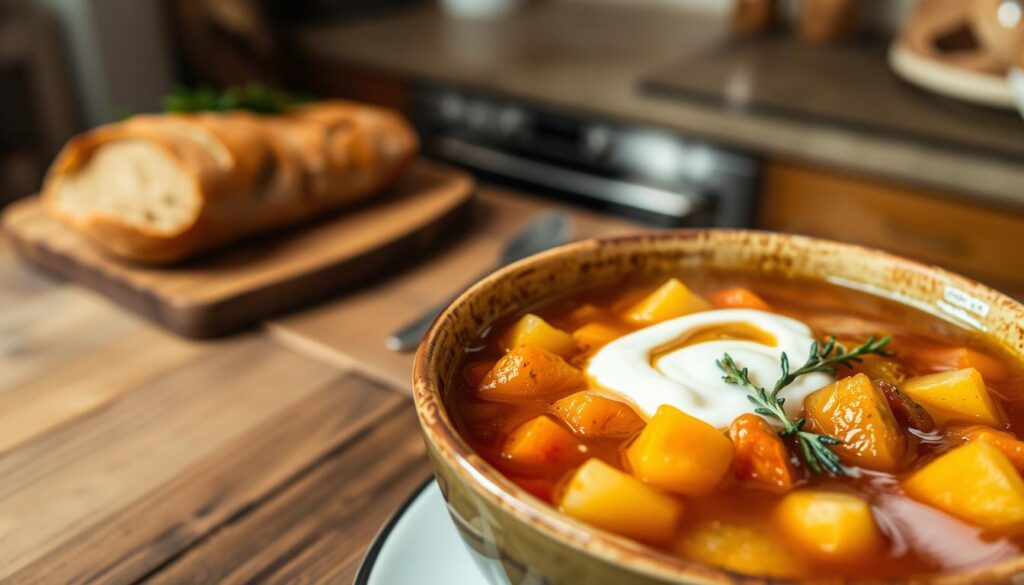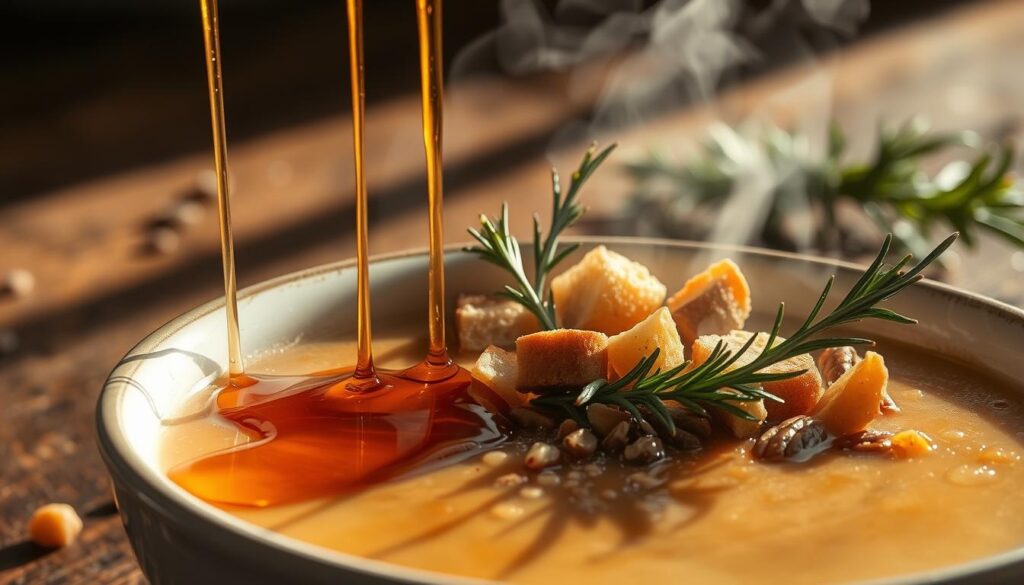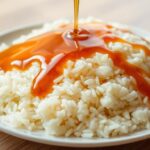Imagine turning a simple soup into a masterpiece with just a bit of maple syrup. Maple syrup is more than just for pancakes. It’s a secret ingredient for both home cooks and chefs. It adds a complex flavor that makes ordinary soups extraordinary.
Chefs know the magic of maple syrup. It adds a sweet and deep flavor that other ingredients can’t match. Its natural complexity blends well with savory tastes, creating new and exciting flavors.
Using maple syrup in soups is an art that requires skill and creativity. In professional kitchens, it’s not just for sweetness. It adds caramel notes and rich flavors that change simple recipes. Soups made with root vegetables, butternut squash, and hearty winter dishes are perfect for maple syrup.
Maple syrup comes in different grades, each with its own flavor. Light amber syrups are subtle, while darker ones have a smoky taste. This makes maple syrup great for adventurous cooks who want to try new flavors.
For chefs, the key is balance when using maple syrup. A little can make a big difference, creating flavors that surprise and please. Whether it’s a rustic vegetable soup or a fancy cream-based dish, maple syrup can change your cooking.
Understanding the Magic of Maple Syrup in Savory Cooking
Cooking with maple syrup turns simple dishes into amazing meals. This natural sweetener adds depth and complexity to savory recipes, like soups. Maple syrup’s flavor is more than just sweet.
Chemical Properties of Maple Syrup in Heat
Heat changes maple syrup in amazing ways. Sugars caramelize, making flavors richer and more complex. This process enhances the taste of savory dishes, like soups.
- Caramelization triggers flavor development
- Molecular breakdown creates depth
- Heat releases subtle taste compounds
Natural Flavor Enhancement Capabilities
Maple syrup boosts the flavor of savory dishes. Its special mix complements other ingredients, making soups and broths taste better.
| Flavor Enhancement Characteristic | Impact on Savory Dishes |
|---|---|
| Sweetness Balance | Neutralizes bitter undertones |
| Depth Creation | Adds complexity to base flavors |
| Aromatic Contribution | Introduces subtle woodsy notes |
Comparing Different Maple Syrup Grades
Choosing the right maple syrup grade is key. Each grade has its own unique traits that can change how soups taste.
- Golden Color, Delicate Taste: Best for light, refined dishes
- Amber Color, Rich Taste: Ideal for robust soup preparations
- Dark Color, Strong Taste: Perfect for intense, hearty recipes
The History of Maple Syrup in Traditional Cuisine
Maple syrup’s journey in cooking goes back centuries. It started with Native American traditions. They first found out how to turn maple tree sap into a sweet, healthy food.
They created special ways to collect and make maple syrup. This syrup was key in their cooking.
Later, early settlers learned from Native Americans how to make maple syrup. They took this knowledge to the northeastern parts of North America. It became a big part of cooking there.
Cooks started using maple syrup in many ways, not just for sweetness. They found it could add flavor to savory dishes too.
- Native Americans pioneered maple sap collection methods
- Settlers adapted indigenous maple syrup processing techniques
- Maple syrup transitioned from basic sweetener to complex culinary ingredient
By the 18th and 19th centuries, maple syrup was a must-have in country kitchens. Families would come together during sugaring season to make their syrup. This made maple syrup a tradition that brought people together.
Cooks got creative with maple syrup, using it in savory dishes. They found it could add a special touch to meats and soups. Maple syrup showed it could be used in many ways, old and new.
“Maple syrup is more than a sweetener—it’s a culinary storyteller connecting generations through taste.” – Traditional Food Historian
Essential Tips for Adding Maple Syrup to Soups
Adding maple syrup to soups can make them truly special. This sweetener brings depth and complexity to your favorite soups. Learning how to use it well can take your cooking to the next level.
Working with maple syrup in soups needs careful thought. Chefs say it’s all about precision and creativity.
Proper Timing and Temperature Control
When adding maple syrup, temperature is key. Here are some important tips:
- Add maple syrup during the final 5-10 minutes of cooking
- Avoid high heat to prevent caramelization and bitter flavors
- Stir gently to ensure even distribution
Measuring and Balancing Sweetness
Finding the right balance is important. Start with a small amount and adjust as needed.
- Begin with 1-2 tablespoons per 4-6 servings
- Taste and adjust incrementally
- Consider the soup’s existing flavor profile
Avoiding Common Mistakes
Many people struggle with maple syrup in soups. Here’s how to avoid common mistakes:
- Select pure maple syrup for authentic flavor
- Understand different syrup grades
- Match syrup intensity with soup ingredients
- Use as a subtle enhancement, not a dominant flavor
Getting good at using maple syrup takes time and practice. Each soup is a chance to discover its sweet possibilities.
Best Types of Soups for Maple Syrup Integration
Exploring maple syrup in soup recipes opens a world of creativity. Some soups are perfect for maple syrup’s unique taste. They turn simple dishes into amazing meals.
Root vegetable soups are great for maple syrup. Sweet potatoes, butternut squash, and parsnips match the syrup’s sweet flavor. These veggies make a great base for maple syrup soups.
- Butternut Squash Soup: Maple syrup adds depth and warmth
- Carrot Ginger Soup: Enhances natural sweetness
- Roasted Parsnip Soup: Balances earthy undertones
Meat-based soups also benefit from maple syrup. Broths with bacon or pork are enhanced by maple’s sweetness. It brings a nice balance of savory and sweet.
International soups offer great chances to use maple syrup. Asian soups, like miso broths or Thai coconut soups, get a boost from maple syrup. It shows how versatile maple syrup is in world cuisine.
Professional chefs suggest starting with a little maple syrup. Then, adjust to find the perfect flavor.
Maple Syrup in Soups: A Complete Guide to Flavor Pairing
Creating tasty maple syrup recipes is all about flavor pairing. Maple syrup’s sweet taste can turn simple soups into amazing dishes. To master this, you need to know how ingredients work together and how to season just right.
Maple syrup is a versatile ingredient that mixes sweet and savory flavors. Chefs use it to add depth and complexity to soups. It’s a key ingredient in cooking.
Compatible Herbs and Spices
Choosing the right herbs and spices can make maple syrup’s flavor pop. Here are some great pairings:
- Thyme – enhances earthy undertones
- Rosemary – adds robust aromatic notes
- Sage – creates a rich, warming sensation
- Cinnamon – deepens the maple’s natural sweetness
- Smoked paprika – introduces subtle smoky dimensions
Complementary Base Ingredients
Some ingredients go well with maple syrup’s taste. Try adding:
- Root vegetables like sweet potatoes and carrots
- Squash varieties such as butternut and acorn
- Hearty proteins like chicken and pork
- Nutty grains including quinoa and barley
Seasonal Pairing Suggestions
Using seasonal ingredients with maple syrup makes flavors even better. Winter is for hearty, warm flavors. Summer is for light, fresh ones.
- Fall: Pumpkin and maple soup with sage
- Winter: Butternut squash soup with maple and cinnamon
- Spring: Carrot soup with maple and ginger
- Summer: Chilled corn soup with maple vinaigrette
Creating Rich Maple-Based Soup Broths
Using maple syrup in soup broths makes them truly special. Its natural sweetness adds depth and complexity. This turns a simple broth into a feast for the taste buds.
Choosing the right maple syrup is key. Dark syrups are best for rich, intense broths. They add a caramel flavor that pairs well with savory ingredients.
- Choose pure, unfiltered maple syrup for maximum flavor
- Start with small quantities to control sweetness
- Pair with complementary herbs like thyme or rosemary
Professional chefs suggest a slow simmer for maple broths. Slow simmering allows the maple syrup to caramelize naturally. This creates a richer flavor base for your soup.
The key to exceptional maple soup broths is patience and precise seasoning.
Try mixing different proteins and vegetables to find new maple broth flavors. These unique creations will amaze your dinner guests.
Butternut Squash Soup with Maple Syrup Enhancement
Creating amazing maple syrup recipes needs creativity and care. Butternut squash soup is a great choice for trying out savory maple syrup dishes. It offers rich, complex flavors that excite your taste buds.
To make a standout butternut squash soup, pick your ingredients wisely and prepare them carefully. The mix of sweet squash and maple syrup makes a perfect dish. It turns a simple recipe into something truly special.
Selecting Premium Ingredients
Choosing top-notch ingredients is key for great maple syrup recipes. Here are the essential items:
- Fresh, locally grown butternut squash
- Pure, grade A maple syrup
- Organic vegetable broth
- Fresh herbs like thyme or sage
- Heavy cream for added richness
Preparation Techniques
Mastering maple syrup dishes means knowing how to cook them right. Follow these steps for a memorable butternut squash soup:
- Roast butternut squash until caramelized
- Sauté aromatic vegetables
- Blend roasted squash with broth
- Incorporate maple syrup
- Adjust seasoning to taste
Pro tip: Add maple syrup gradually to control sweetness and enhance the soup’s depth of flavor.
Savory Maple and Root Vegetable Combinations

Exploring maple syrup in savory dishes is a culinary adventure. It’s amazing when paired with root vegetables. Maple syrup turns simple root vegetable soups into unforgettable meals.
Carrots, parsnips, and sweet potatoes are great for maple syrup. Their earthy taste matches the syrup’s sweetness perfectly.
- Roast root vegetables with a maple glaze before adding to soups
- Use darker maple syrup grades for more intense flavor
- Experiment with different root vegetable combinations
Chefs have tips for better flavor:
- Caramelize root vegetables with maple syrup
- Drizzle maple syrup during the final cooking stages
- Create a maple-infused broth as a base
The secret is finding the right balance. A little maple syrup can make a simple soup into a gourmet delight.
Maple syrup isn’t just for pancakes – it’s a secret weapon in savory cooking!
Maple Syrup and Bacon Soup Recipes
Culinary fans love the mix of maple syrup and bacon in savory dishes. This combo brings sweet and smoky tastes together. It turns simple soups into amazing meals.
Making maple syrup and bacon soup needs skill and knowing how to mix flavors. Chefs can make their soups stand out by using these ingredients wisely.
Smoky Flavor Integration Techniques
To add depth to maple syrup and bacon soup, follow these steps:
- Choose high-quality smoked bacon for a strong taste
- Slowly cook bacon fat to get the most smokiness
- Add a bit of liquid smoke for more complexity
- Caramelize maple syrup with bacon for a rich flavor
Texture Balance Techniques
To get the right soup texture, manage your ingredients well:
- Top with crispy bacon for a nice crunch
- Puree some bacon for a smooth base flavor
- Use maple syrup carefully to avoid too much sweetness
- Find the right mix of protein and veggies for the best feel
These savory maple syrup dishes show how versatile maple syrup is in cooking. With practice, home cooks can make meals that impress and amaze.
Asian-Inspired Soups with Maple Undertones
Exploring maple syrup in Asian cuisine is exciting. Its sweet taste adds a new twist to Asian soups. It brings together flavors from East and West.
Maple syrup can change classic Asian soups into something new and complex. Chefs find it blends well with Asian soup traditions.
- Miso soup with a maple undertone
- Ramen enhanced by subtle maple glazing
- Hot and sour soup with maple complexity
Here’s how to use maple syrup in Asian soups:
- Choose light-grade maple syrup for a light flavor.
- Add maple syrup at the end of cooking.
- Balance sweetness with umami-rich ingredients.
“Maple syrup is not just for pancakes—it’s a global ingredient that can elevate any cuisine.” – Chef Michael Chen
Spices like ginger, star anise, and five-spice powder pair well with maple syrup. They create flavors that surprise and please.
Start with a little maple syrup, then add more. The goal is to add depth without overpowering the soup.
Maple Syrup Vinaigrette for Soup Garnishing
Turning soup presentations into art is easy with maple syrup vinaigrette. This dressing makes simple soups taste like gourmet dishes. It adds depth and complexity to any recipe. Chefs and home cooks love how it makes meals unforgettable.
Making a tasty maple syrup vinaigrette soup topping is all about the right ingredients and techniques. The perfect mix of sweet and tangy can really boost your soup’s taste.
Quick Preparation Methods
Here’s how to make a maple syrup vinaigrette:
- Select high-quality maple syrup
- Choose complementary vinegar (apple cider or white wine)
- Blend with olive oil
- Add seasoning like dijon mustard or herbs
Storage and Shelf Life
Keeping your maple syrup vinaigrette fresh is important. It should be stored in the fridge.
| Storage Method | Shelf Life | Recommended Container |
|---|---|---|
| Refrigerated | 7-10 days | Glass jar with tight lid |
| Room Temperature | 2-3 days | Not recommended |
For the best taste, use fresh ingredients. Store your vinaigrette in a clean, sealed container. It’s great with root vegetable soups, butternut squash, and creamy soups.
Creative Maple Syrup Soup Toppings

Adding a twist to soup presentation is more than just garnishes. Maple syrup glaze for soups brings new life to dishes. These toppings not only boost flavor but also make your soups look great.
Making unique maple syrup toppings needs skill and the right ingredients. The aim is to match the soup’s taste while adding interesting textures.
- Maple-Candied Nut Crumbles
- Crispy Maple Bacon Bits
- Maple-Infused Herb Sprinkles
- Caramelized Maple Croutons
Experts say it’s important to mix sweet and savory when using maple syrup in toppings. Precision is key – too much sugar can mask the soup’s taste.
| Topping Type | Preparation Time | Flavor Profile |
|---|---|---|
| Maple-Glazed Pecans | 15 minutes | Rich, Caramelized |
| Maple Bacon Crumbles | 20 minutes | Smoky, Sweet |
| Maple Herb Sprinkle | 5 minutes | Fresh, Aromatic |
Trying new maple syrup toppings in soups can improve your cooking. Each topping adds a special touch, turning simple soups into fancy dishes.
Health Benefits of Adding Maple Syrup to Soups
Cooking with maple syrup adds more than flavor to your soups. It brings nutritional benefits that boost taste and health. Learning about maple syrup’s advantages in soups can change how you cook for health.
Maple syrup is packed with minerals and antioxidants. It’s a better choice than refined sugars because it adds real nutritional value to soups.
Nutritional Powerhouse
Maple syrup is a special ingredient in soups because of its minerals. Research shows it has several key nutrients:
- Zinc: Supports immune system function
- Manganese: Helps bone health and metabolism
- Calcium: Promotes strong bones and muscles
- Potassium: Regulates heart and muscle activities
Dietary Considerations
When using maple syrup in soups, use it in moderation. It’s a good choice for those looking for lower-glycemic options. It’s better for blood sugar control than regular sugar.
Maple syrup in soups is a smart way to add sweetness without losing nutritional value. By choosing and measuring it wisely, you can make healthy, tasty soups that are good for you.
Troubleshooting Common Issues with Maple Syrup in Soups
Cooking with maple syrup in soups can sometimes present challenges for home chefs. Understanding how to navigate these issues ensures a delightful culinary experience with maple syrup in soups.
Sweetness management is key when using maple syrup in soups. Chefs often struggle to find the perfect balance of flavors. Here are some strategies to overcome common maple syrup cooking challenges:
- Prevent over-sweetening by adding maple syrup gradually
- Use lighter maple syrup grades for delicate soup bases
- Adjust seasoning to counterbalance sweetness
Texture complications can arise when maple syrup interacts with different soup ingredients. Temperature control plays a critical role in maintaining consistency. Rapid heating or excessive stirring might cause separation or crystallization.
Professional chefs recommend these practical solutions for maple syrup soup challenges:
- Whisk maple syrup into warm (not boiling) liquid
- Use an immersion blender to reintegrate separated ingredients
- Add acidic ingredients like vinegar to balance sweetness
If maple syrup flavor seems too subtle, consider these enhancement techniques. Roasting vegetables before adding them to the soup can intensify maple undertones. Reducing the liquid slightly can also concentrate maple flavors.
Mastering maple syrup in soups requires patience and practice.
Expert Chef Tips for Maple Syrup Soup Enhancement
Professional chefs know how to make savory soups special with maple syrup. They use it to add depth and complexity to dishes. This natural sweetener can turn simple soups into amazing meals.
Top chefs say picking the right maple syrup grade is key. Dark amber maple syrup is best for thick, hearty soups. Lighter grades are better for soups with vegetables. It’s all about how maple syrup works with other flavors.
- Choose fresh, high-quality maple syrup from reputable producers
- Add maple syrup gradually to control sweetness levels
- Introduce maple syrup during the final stages of cooking
- Pair with complementary herbs like thyme and rosemary
When making maple syrup soups, chefs stress the importance of precision. They use digital thermometers to keep temperatures right and avoid caramelization. Even small changes can make a big difference in taste.
“Maple syrup isn’t just a sweetener – it’s a flavor enhancer that brings complexity to savory dishes,” says Chef Michael LeBlanc, a renowned culinary expert.
Chefs also suggest making maple-infused broths and using syrup as a glaze. They encourage trying different amounts of maple syrup to find new flavors. This way, you can create dishes that excite your taste buds.
Conclusion
Exploring maple syrup in soups opens a world of creativity in cooking. It turns simple recipes into amazing meals. Maple syrup is not just for breakfast anymore. It’s a versatile ingredient that makes savory dishes richer and more complex.
Maple syrup adds a unique touch to soups, blending natural sweetness with cooking skills. It can change root vegetable purees and broths in exciting ways. The secret is knowing how to use it right, balancing flavors, and mastering the art of adding maple syrup.
Culinary explorers can now try maple-enhanced soup recipes that break new ground. Whether making Asian broths, hearty vegetable soups, or creative garnishes, maple syrup adds a touch of elegance. This lets home cooks see soup making as a fun and creative journey.
Starting your maple-infused soup journey means embracing the art of cooking. The tips and ideas in this guide are just the beginning. Be bold, trust your taste, and enjoy the tasty adventures maple syrup brings to your soups.



